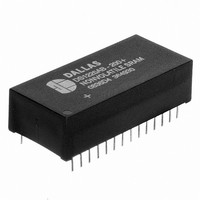DS1243Y-120 Maxim Integrated Products, DS1243Y-120 Datasheet - Page 4

DS1243Y-120
Manufacturer Part Number
DS1243Y-120
Description
IC NVSRAM 64KBIT 120NS 28DIP
Manufacturer
Maxim Integrated Products
Datasheet
1.DS1243Y-120.pdf
(13 pages)
Specifications of DS1243Y-120
Format - Memory
RAM
Memory Type
NVSRAM (Non-Volatile SRAM)
Memory Size
64K (8K x 8)
Speed
120ns
Interface
Parallel
Voltage - Supply
4.5 V ~ 5.5 V
Operating Temperature
0°C ~ 70°C
Package / Case
28-DIP Module (600 mil), 28-EDIP
Lead Free Status / RoHS Status
Contains lead / RoHS non-compliant
Other names
DS1243Y120
Available stocks
Company
Part Number
Manufacturer
Quantity
Price
Company:
Part Number:
DS1243Y-120
Manufacturer:
DALLAS
Quantity:
504
Part Number:
DS1243Y-120
Manufacturer:
DALLAS
Quantity:
20 000
Company:
Part Number:
DS1243Y-120+
Manufacturer:
LT
Quantity:
50
PHANTOM CLOCK OPERATION
Communication with the Phantom Clock is established by pattern recognition on a serial bit stream of 64
bits which must be matched by executing 64 consecutive write cycles containing the proper data on DQ0.
All accesses which occur prior to recognition of the 64–bit pattern are directed to memory.
After recognition is established, the next 64 read or write cycles either extract or update data in the
Phantom Clock, and memory access is inhibited.
Data transfer to and from the timekeeping function is accomplished with a serial bit stream under control
of Chip Enable (
location using the
moving a pointer to the first bit of the 64–bit comparison register. Next, 64 consecutive write cycles are
executed using the
access to the Phantom Clock. Therefore, any address to the memory in the socket is acceptable.
However, the write cycles generated to gain access to the Phantom Clock are also writing data to a
location in the mated RAM. The preferred way to manage this requirement is to set aside just one address
location in RAM as a Phantom Clock scratch pad. When the first write cycle is executed, it is compared
to bit 0 of the 64–bit comparison register. If a match is found, the pointer increments to the next location
of the comparison register and awaits the next write cycle. If a match is not found, the pointer does not
advance and all subsequent write cycles are ignored. If a read cycle occurs at any time during pattern
recognition, the present sequence is aborted and the comparison register pointer is reset. Pattern
recognition continues for a total of 64 write cycles as described above until all the bits in the comparison
register have been matched (this bit pattern is shown in Figure 1). With a correct match for 64 bits, the
Phantom Clock is enabled and data transfer to or from the timekeeping registers can proceed. The next 64
cycles will cause the Phantom Clock to either receive or transmit data on DQ0, depending on the level of
the
Clock.
PHANTOM CLOCK REGISTER INFORMATION
The Phantom Clock information is contained in 8 registers of 8 bits, each of which is sequentially
accessed 1 bit at a time after the 64–bit pattern recognition sequence has been completed. When updating
the Phantom Clock registers, each register must be handled in groups of 8 bits. Writing and reading
individual bits within a register could produce erroneous results. These read/write registers are defined in
Figure 2.
Data contained in the Phantom Clock register is in binary coded decimal format (BCD). Reading and
writing the registers is always accomplished by stepping through all 8 registers, starting with bit 0 of
register 0 and ending with bit 7 of register 7.
CE
OE
cycles without interrupting the pattern recognition sequence or data transfer sequence to the Phantom
pin or the
CE
CE
WE
CE
), Output Enable (
and
and
pin. Cycles to other locations outside the memory block can be interleaved with
OE
WE
control of the Phantom Clock starts the pattern recognition sequence by
control of the SmartWatch. These 64 write cycles are used only to gain
OE
), and Write Enable (
4 of 13
WE
). Initially, a read cycle to any memory
DS1243Y














